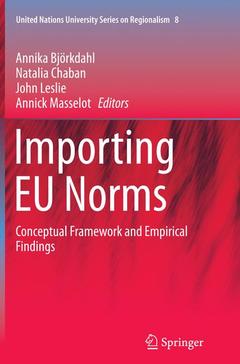Importing EU Norms, Softcover reprint of the original 1st ed. 2015 Conceptual Framework and Empirical Findings United Nations University Series on Regionalism Series, Vol. 8
Coordonnateurs : Björkdahl Annika, Chaban Natalia, Leslie John, Masselot Annick

Presents a conceptual framework and empirical cases of the EU as an ‘exporter of norms’, which are linked to that framework
Examines the effectiveness of norm export and evaluates to what extent it is enhanced or inhibited by different transfer mechanisms
Provides comprehensive analyses and comparisons of EU's norm export in a wider geographical setting, both within and beyond Europe’s neighbourhood
Includes supplementary material: sn.pub/extras
Date de parution : 10-2016
Ouvrage de 262 p.
15.5x23.5 cm
Disponible chez l'éditeur (délai d'approvisionnement : 15 jours).
Prix indicatif 52,74 €
Ajouter au panierDate de parution : 03-2015
Ouvrage de 262 p.
15.5x23.5 cm
Disponible chez l'éditeur (délai d'approvisionnement : 15 jours).
Prix indicatif 52,74 €
Ajouter au panierThème d’Importing EU Norms :
Mots-clés :
Accession of the Czech Republic in the Eurozone; Construction of the Trans-Tasman Single Economic Market; Diffusion of EU Norms to China; EPA-Negotiations; Europe and Global Economic Governance; European Integration; Free Movement Norms in a European Cross-Border Regions; Free Movement in the Cross-Border Oresund Region; Gender Equality in EU-Asian Trade Policy; Global Economic Governance in the EU; Normative Leadership in Economic Crisis; Normative Power Europe; Perspectives after the Euro Sovereign Debt C



